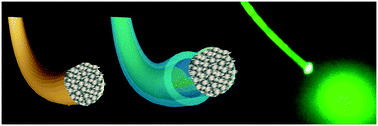Real-time optical fiber sensors based on light diffusing microlens arrays
Abstract
The applications of optical fibers are impeded in implantable medical diagnostics due to incompatibility with biological tissues, and immune reaction in vivo. The utilization of biocompatible materials to construct a photonic sensing platform can reduce the immune response in in vivo medical diagnostics. Here, we developed real-time optical fiber sensors to determine the volumetric modulation of stimuli-responsive polymers. Asymmetric microlens structures were replicated on stimuli-sensitive hydrogels as stand-alone sensors and were chemically attached to the tips of silica and biocompatible optical fibers. Quantitative measurements were carried out using a smartphone to demonstrate the ease, simplicity, and practicality of the readout methodology. To demonstrate the utility in real-time sensing, the fiber probe was investigated in various concentrations of ethanol, propan-2-ol, and dimethyl sulfoxide. Also, the fiber probe showed a rapid response to pH in the acidic region with a sensitivity of 40 nW pH−1. To develop biocompatible probes for physiological applications, a microlens array-imprinted polymer was attached to the tip of a hydrogel optical fiber. The optical fiber probe in the refection configuration showed a sensitivity of 7 nW pH−1. The developed hydrogel fiber probes may have application in point-of-care diagnostics, continuous biomarker monitoring, and critical care sensing devices.

- This article is part of the themed collection: Wearable and Implantable Sensors


 Please wait while we load your content...
Please wait while we load your content...